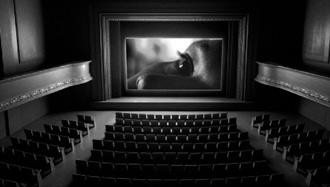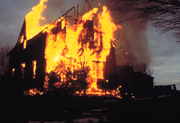 Film
FilmOur vertigo is heightened, however, by the sounds that we hear all around us in the headphones as well as by realizing that we are in steeply raked seats right at the top of this theatre: in the 'gods' as we say in England or, as the French would have it, the 'paradis.' The headphones that we wear in this paradise convey the impression of a bustling audience (from the Latin audire-'to hear') moving, chatting and eating popcorn. "What's all this about? What is this? Why are we here?" ask different members of a jokey-sounding group. Throughout the film various people in the 'audience' get up or come back, making noise, making distractions, disrupting the smooth flow of the film whose soundtrack also comes through the headphones.
Our experience as a group in the theatre is split between sound and sight. We know that we share the same sights as the other people inside "The Paradise Institute" but, although we suspect that our soundtracks are the same, we are walled into our own heads by the headphones. This has the effect of preserving the inscrutable silence for the people outside the Institute but it also divides the audience into a number of individual auditors who react simultaneously to the sounds of the Institute despite being cut off from one another.
This strange dichotomy of inside and outside is echoed by the themes of the noises and voices. Although they seem to be split between sounds coming from the film and sounds of an imaginary audience, the film and the audience are linked somehow. The voices are the same, the woman who has to leave the auditorium because she is convinced she has left the stove on, is explicitly linked to the burning house we see in the film by a narrator who sounds to be speaking in the film. Either sound, one of Cardiff's primary working media, is the pre-eminent context for the film, or the film is the pre-eminent context for the soundscape.
 "The Paradise Institute" is a meditation on the frame, and consequently on
what it means to watch and judge that which is within the frame. Film is
the ideal medium to comment on the concept of the frame. Composed, as it
is, of thousands of framed pictures that are dependent on their context
(after the previous picture, in front of the projector) for meaning, being
framed and contextualized is the ultimate condition of film. As well as
the frames of film, and the physical plywood box that encloses the
observers, the narrative of the film, such as it is, thematizes the threat
into which it is placing frameworks and restrictions. It suggests it is
one thing and immediately suggests it is wrong. It is both a wooden
structure and the display of a burning wooden house, it is a story about
liberation that demands exact submission to the seat and headphone and
screen. As an artwork it is conscious that it embodies and critiques many
of the same things and wonders, almost to itself, "How long did you think
you could get away with playing both sides?"
"The Paradise Institute" is a meditation on the frame, and consequently on
what it means to watch and judge that which is within the frame. Film is
the ideal medium to comment on the concept of the frame. Composed, as it
is, of thousands of framed pictures that are dependent on their context
(after the previous picture, in front of the projector) for meaning, being
framed and contextualized is the ultimate condition of film. As well as
the frames of film, and the physical plywood box that encloses the
observers, the narrative of the film, such as it is, thematizes the threat
into which it is placing frameworks and restrictions. It suggests it is
one thing and immediately suggests it is wrong. It is both a wooden
structure and the display of a burning wooden house, it is a story about
liberation that demands exact submission to the seat and headphone and
screen. As an artwork it is conscious that it embodies and critiques many
of the same things and wonders, almost to itself, "How long did you think
you could get away with playing both sides?"
The story has something to do with a man who is strapped down and half-asleep and his nurse who is trying to free him. One could also speculate here about the relation of the nurse/man and the artists to one another, not least because the film is not framed by titles explaining who did what, as we expect films to be. In this case the internal frame is missing, and, we assume, is replaced by the external frame of authorship provided by Miller and Cardiff.
The more fruitful speculation is on the metaphorical nature of the bound man. He is half-asleep, almost an automaton, not yet able or ready to leave when his nurse comes to rescue him. Does he stand for the audience strapped into submissive reception of the film, or does he stand for the film itself, strapped into the projector and unfreeable until the film is ended? Since the audience and film are bound to one another by "The Paradise Institute" itself, perhaps it doesn't matter.
The work is not just about the plyboard-walling of cinematic paradise but, while using many of its conventions and abilities, "The Paradise Institute" suggests how one might critique the institution of fantasy constituted by the film industry. By bringing the institution of the frame into new and complex question, Cardiff and Miller suggest an enterprise that has a bearing on decisions as diverse as deep ontology and water-cooler banter. The only thing that we find against all authority is the frame and bulwark of that authority itself.
It would indeed be paradise to accede to no authority and to live within the frame of a fully enclosed and fully defined world-like being a baby that believes it is the sum of the world. Fortunately, we live among people, in an open society where we deal daily with the competing claims of multiple authorities, not least out own.
What any film offers us is a chance to think about its continually replaced frames as a whole, beyond the individual frames. What Cardiff and Miller remind us in "The Paradise Institute" is that the authority of a reproducible act is also a product of the frame within which it is reproduced. And that authority must not be overlooked or granted by wealth or history but must be earned as one would ear respect from a friend or stranger.
|
|
April, 2002
Frederick Wiseman takes us inside the pervasive, sinister institution of
domestic violence.
March, 2002
Cinema can help expose ourselves to the world, or it can seduce us to sit
back and relax.
February, 2002
Harry Potter is cute, but is it a bad thing that adults crave escapism?



film politics music jay's head poetry art masthead letters archive